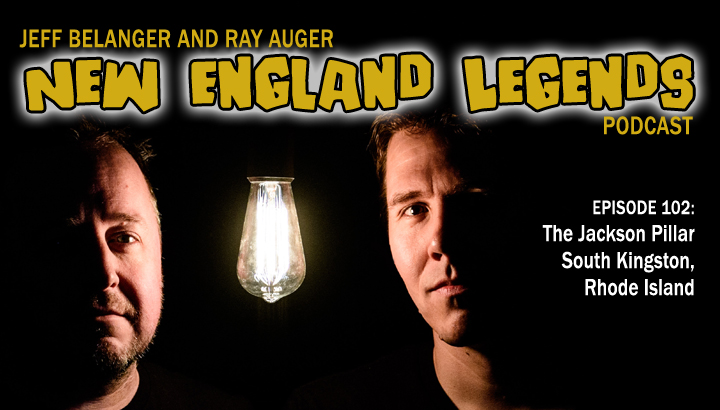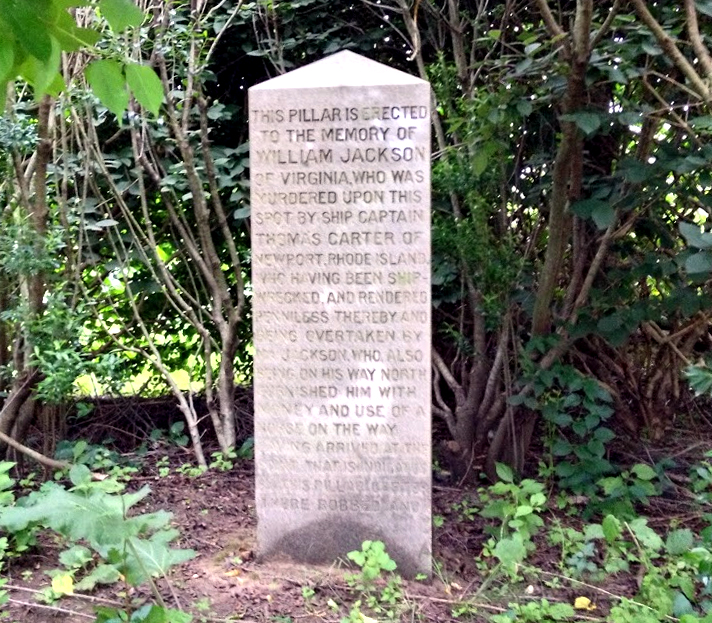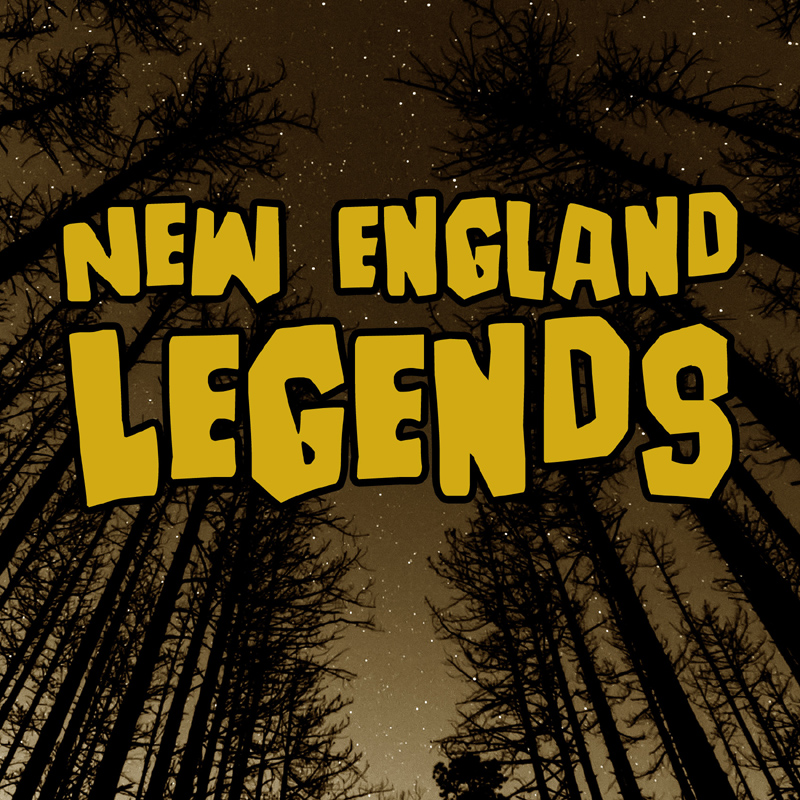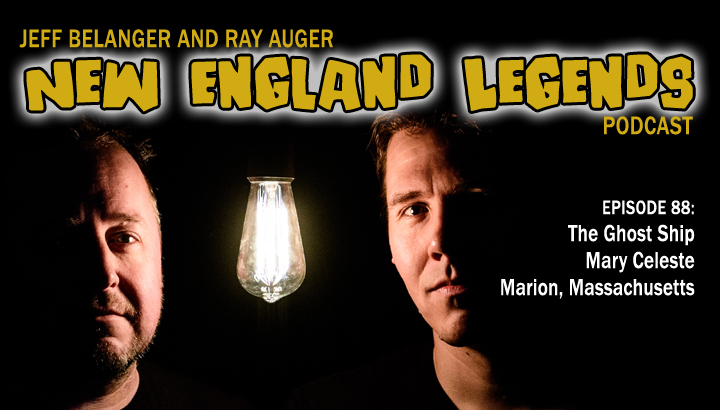
In Episode 102, Jeff Belanger and Ray Auger visits the bushes next to Rt. 1 in South Kingston, Rhode Island, in search of the Jackson Pillar. This pillar is a stone monument telling the story of a gruesome murder of William Jackson that took place here in 1751. It’s a murder that would have been lost to time if not for this stone and the story of the aftermath.
CALL (OR TEXT) OUR LEGEND LINE:
(617) 444-9683 – leave us a message with a question, experience, or story you want to share!
BECOME A LEGENDARY LISTENER PATRON:
https://www.patreon.com/NewEnglandLegends
CREDITS:
Produced and hosted by: Jeff Belanger and Ray Auger
Edited by: Ray Auger
Theme Music by: John Judd
SUBSCRIBE TO THE PODCAST FOR FREE:
iTunes | Google Play | Spotify | Stitcher | TuneIn | iHeartRadio
JOIN OUR SUPER-SECRET:
New England Legends Facebook Group

The Jackson Pillar by Rout 1 in South Kingston, Rhode Island.
EPISODE TRANSCRIPT:
*A note on the text: Please forgive punctuation, spelling, and grammar mistakes. Like us, the transcripts ain’t perfect.
[SFX CARS DRIVING BY]
RAY: So Jeff, we’re looking for a stone on the side of the road in South Kingston, Rhode Island?
JEFF: That’s right, Ray.
RAY: That’s not much to go on. There are stones and rocks everywhere here along the side of Rt. 1.
JEFF: This isn’t so much a rock, but a monument to an event that took place here back in 1751. This monument marks the scene of a murder.
[INTRO]
JEFF: Hi, I’m Jeff Belanger.
RAY: And I’m Ray Auger, and welcome to episode 102 of the New England Legends podcast. If you give us about 10 minutes, we’ll give you something strange to talk about today. Thank you for joining us on our mission to chronicle every legend in New England one week and one story at a time.
JEFF: And we couldn’t do that without the help of our patreon patrons who are sponsoring this week’s episode. If you head over to patreon.com/newenglandlegends, for as little as $3 bucks per month you’ll get early access to new episodes, plus bonus episodes that no one else gets to hear. Thank you to everyone who has been supporting us!
RAY: If you enjoy our stories each week, please post a review on iTunes. Those reviews really help other people find our show. So Jeff, about this rock on the side of a busy road.
[SFX CARS PASSING BY]
JEFF: Yeah, this is a hidden nugget that I’ve heard is going to be found in the bushes somewhere near here.
RAY: And it’s the site of a murder?
JEFF: Yes, the murder of William Jackson by Thomas Carter.
RAY: I haven’t heard of either of those men.
JEFF: Me neither. This is a murder that would be forgotten if not for this stone, and considering how overgrown the area is now, this murder would be almost forgotten if not for this story. But at the time, it was a very big deal. Big enough to make international news and warrant a monument. Not too many murders can do that.
RAY: And yet, I don’t see this monument anywhere.
JEFF: I think we’re going to have to bush-whack into some of these hedges and shrubs to find it.
[SFX WALKING WOODS/CUTTING/WHACKING]
RAY: Okay, there it is in the middle of a bunch of overgrown bushes. It’s a stone obelisk, maybe four feet high, with writing on all sides.
JEFF: If we didn’t know roughly where to look, we would have never found this monument. And that writing tells the whole story of the murder, or at least it tells the version Joseph Peace Hazard wanted us to know in 1889, which is 138 years after the crime. Go ahead and give the east side of this pillar a read, Ray.
RAY: Okay, it says: This pillar is erected to the memory of William Jackson of Virginia, who was murdered upon this spot by ship captain Thomas Carter of Newport, Rhode Island, who, having been ship-wrecked and rendered penniless thereby, and being overtaken by Mr. Jackson, who, also being on his way North, furnished him with money and use of a horse on the way. Having arrived at the point that is indicated by this pillar, Carter there robbed and murdered his kind and confiding benefactor with a dagger, about the hour of midnight of January first, 1751.
JEFF: Brutal, huh?
RAY: Yeah, but I’m guessing these aren’t all the facts?
JEFF: No they’re not. And while both the victim and murderer aren’t all that significant historically speaking, what happened after the murder is the reason this monument and their story survives to this day. Even if the backstory is murky at best.
RAY: Let’s head all the way back to 1750, and figure out why this is here.
[SFX TRANSITION]
RAY: Okay, the old Post Road looks a lot different here in 1750. Just a long dirt wagon road running through a very rural part of Rhode Island.
JEFF: And it’s a bit chilly considering it’s New Year’s Eve. We’re just hours away from 1751. Here’s what we know. Captain Thomas Carter may have been the master of a small vessel, but others have said he was a privateer.
RAY: A privateer is basically a sailor who is armed and can be hired to fight for your cause. A mercenary. And just a half-step away from being a pirate.
JEFF: Exactly. The only difference between a privateer and a pirate is that a pirate is a privateer who works for himself. So somewhere along the way, Captain Carter finds himself shipwrecked and a kindly William Jackson takes him in, gives him clothes and food and agrees to help Captain Carter get north. The two make their way to Rhode Island where they begin to travel on horseback. Jackson is described as wearing wash-leather small clothes, which are close-fitting knee britches, a snuff-colored jacket and a red overcoat. At his side he carries a saw-backed hanger, which is a short broad sword with a serrated edge like a steak knife. He also has a silver watch with a green ribbon for a chain.
RAY: For a while, their journey seems to be going fine. But then the men reached the vicinity of Willard Tavern. That’s when, without warning, Captain Carter strikes Jackson with a stone, knocking him from his horse.
[SFX THUMP]
RAY: Jackson lays on the ground bleeding, and pleading for his life. But Captain Carter leaps on top of Jackson, grabs his hanger, and stabs Jackson to death.
JEFF: Captain Carter drags Jackson’s lifeless body to the banks of the nearby Pettaquamscutt River, breaks up the ice using Jackson’s hanger,
[SFX CHIPPING ICE]
JEFF: Then slides Jackson’s dead body beneath the surface to cover his tracks. Captain Carter, it would seem, has just gotten away with murder.
RAY: But only for the moment. A few days later, though some sources will claim it was several weeks later, Jackson’s naked body is discovered by a fisherman named J.R. Cole. The body has clearly been stabbed twice in the chest and once in the neck with a serrated blade.
JEFF: The coroner makes some inquiries and learned how Jackson had been seen traveling with Captain Carter December 31st, and how Carter had been witnessed a few days later carrying a silver pocket watch, an old hanger blade, and a red overcoat.
RAY: Carter is arrested on February 23rd 1751, and brought to South Kingston’s jail while he awaits trial at the Kings County Courthouse.
JEFF: During the trials, an innkeeper’s wife, a Mrs. Nash, recognized the buttons she had helped sew on Jackson’s coat before the murder. The same coat found on Captain Carter.
RAY: The trial doesn’t last long. People are outraged that a man like Captain Carter would murder someone who arguably saved his life, gave him clothes, and helped him get back to Rhode Island.
[SFX GAVEL HITTING WOODEN BENCH THREE TIMES]
JUDGE: Guilty!
RAY: And Captain Carter now finds himself facing one of the most gruesome and barbaric death penalties Rhode Island has ever seen.
JEFF: What are they going to do to him?
RAY: First, they’re going to hang him. Then place his body in a gibbet—a series of iron shackles strapped to the arms, legs, torso, and the head of a body so it can hang until the flesh is gone and the bones fall to the ground.
JEFF: That’s horrible.
RAY: The body on display is meant to serve as a warning to others that crimes like murder will not be tolerated.
JEFF: How long will a body last in a gibbet?
RAY: In the case of Captain Carter… (DRAMA) years.
JEFF: Years?!
RAY: Years.
JEFF: According to newspaper accounts, 10,000 people witnessed the hanging. This story was printed in newspapers in England as well, because everyone is shocked at the circumstances. Plus, thousands more witnesses will see Captain Carter’s rotting body in the coming years as a reminder.
RAY: As you can imagine, this whole event burns itself into the permanent memory of this community. Locals talk about how Carter’s rusty chains would cry and shriek during particularly windy or stormy nights terrorizing those who pass by. Captain Carter’s hanging corpse is a thing to gawk at for years until the remains are finally taken down. That gruesome decoration forced some tough discussions about the death penalty, and the evidence used to condemn Captain Carter to death.
JEFF: So people doubted Carter’s guilt?
RAY: Plenty of people. Some claim Carter wrote a confession shortly before his execution on May 10, 1751. But the confession is recorded only by a court clerk. As some historians have pointed out, a confession of guilt would have been widely published and circulated, because just as they do today, the courts love vindication that they got it right.
JEFF: But this confession doesn’t make the rounds. It’s just a footnote.
RAY: Which would never happen.
JEFF: From here, the details of the case get murky. Memory fades. Various versions of what happened circulate, but one thing everyone remembers with crystal clarity is the rotting corpse of Captain Carter hanging for all to see.
RAY: From here we jump ahead to 1889. A local Rhode Island legend in his own right named Joseph Peace Hazard, feels compelled by the story of Captain Carter’s hanging.
JEFF: Hazard is a Spiritualist. He believes in direct spirit communication with those who have passed on, so perhaps what Hazard does next was born out of contact with the spirit of Carter, or maybe even Jackson, or perhaps both. In 1889, Joseph Peace Hazard builds a stone obelisk monument which tells the story of the murder and trial on all four sides of the stone and places that marker right here. And that brings us back to today.
[SFX TRANSITION]
RAY: So this stone monument has been here since 1889?
JEFF: It has, and Rhode Island has grown up quite a bit since then.
RAY: Right, Route 1 runs right next to the stone, these bushes and shrubs have covered it up, and it’s almost been completely forgotten. Why do you think Joseph Hazard put this up?
JEFF: I think our biggest clue as to why this is here can be found on the south side, or the fourth side of the pillar. Go ahead and give it a read, Ray.
RAY: Okay, it says: Mrs. Nash, who lived about ten miles westward from Tower Hill, happening to be at this village at the time this body was found. She recognized it as being that of Jackson, by means of a button she had sewn upon his vest only a few hours before he left her house, and that Captain Carter was with him. Carter was therefore arrested, tried, and condemned, and executed accordingly.
JEFF: That’s the story as Hazard heard it.
RAY: When you read it that way, it doesn’t sound like much evidence to condemn a man to death and to display his corpse for all to see. A man with no motive other than a minor robbery from someone who saved his life.
JEFF: No, it doesn’t sound like much evidence. Hazard is editorializing here without preaching.
RAY: Is he against the death penalty or something like that?
JEFF: I would think he was. But you also have to remember that Rhode Island’s last execution was February 14, 1845. So it’s not exactly a problem in Rhode Island in 1889.
RAY: The crazy thing about this story, is there are many variations on what exactly happened with this murder. Different historians have gone digging and found only a few consistencies. One: everyone agrees that Captain Carter and William Jackson knew each other and were traveling together at some point. And two: Jackson was murdered and Captain Carter was hanged and put on display for years after because of it.
JEFF: And we only know all this because of Joseph Hazard. Otherwise, this story would have been lost to history. Who would go looking for it if not for this strange monument by Route 1?
RAY: So Hazard puts this monument up as a reminder of how barbaric we can be. And maybe a warning to Rhode Island not to act like that again.
JEFF: And we’ve let it get hidden away and almost completely forgotten, if not for a story that still floats around thanks to a monument that begs us to ask more questions and to take a hard look at who were are.
[OUTTRO]
RAY: I love finding these hidden gems. By exploring the past and the legends that follow, I feel like we learn more about ourselves.
JEFF: And knowing is half the battle.
RAY: Was that a GI Joe reference?!
JEFF: Go Joe. If you’ve got a story tip for us, or a strange tail you’d like to see covered on New England Legends, you can reach out to us. Call or text our legend line anytime.
RAY: That’s 617-444-9683
JEFF: Our contact us through our Web site.
RAY: Ournewenglandlegends.com
JEFF: On our web site you’ll find all of our past episodes, video clips, plus dates for my ongoing story tour. And you can also join our super-secret Facebook group.
RAY: That’s a secret. But if you’re clever, you can find it.
JEFF: Also feel free to reach out to me or Ray on social media. Just use the hashtag newenglandlegends so we can find you.
RAY: And of course our theme music is by John Judd.
JEFF: Until next time remember… the bizarre is closer than you think!
Copyright © 2019 New England Legends. All rights reserved.



